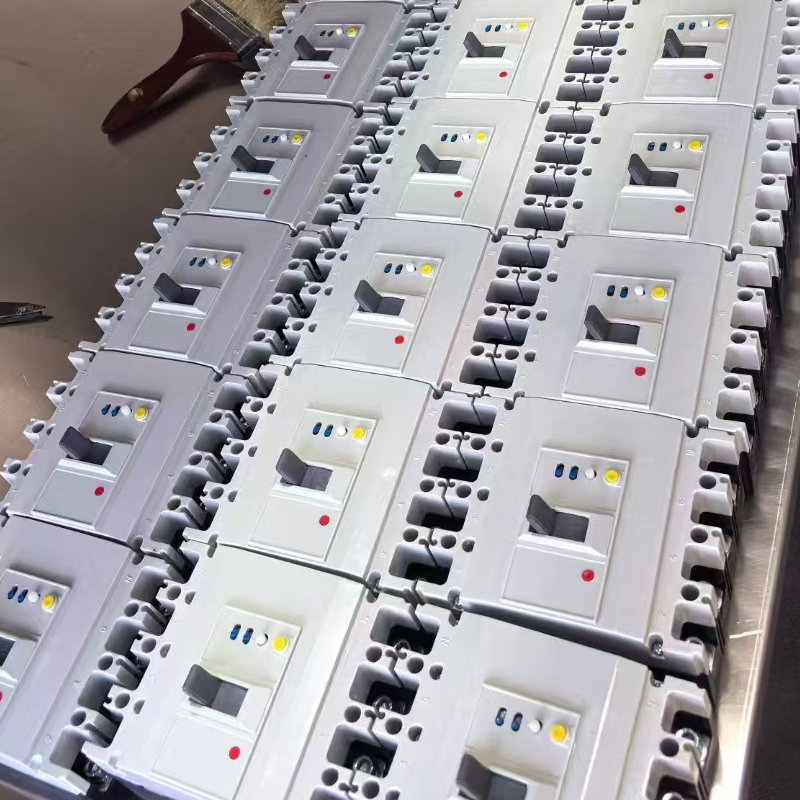NEWS
Manufacturing of molded case circuit breakers
Writer:qbkg Time:2024-08-31 Browse:1,246℃
Introduction
Molded case circuit breakers (MCCBs) are key components of electrical systems that protect against overcurrent, short circuits, and ground faults. Their manufacturing requires high precision and strict quality control to ensure reliable operation in various scenarios.
Material selection
Casing materials
Polycarbonate and ABS are commonly used. Polycarbonate is impact-resistant and heat-resistant, and can withstand the thermal stress of circuit breaker operation; ABS is dimensionally stable and low-cost. Both have excellent electrical insulation and can prevent leakage.
Contact materials
Contacts require highly conductive, wear-resistant and arc-resistant materials, and silver-plated copper alloys are often selected. Silver has high conductivity, and the coating can reduce contact resistance and prevent oxidation, ensuring stable connection when the contacts are connected and disconnected.
Electromagnetic and thermal elements
The trip unit contains electromagnetic and thermal elements. Electromagnetic elements are mostly ferromagnetic materials, which generate magnetic fields to drive tripping when overcurrent or short circuit occurs; thermal elements such as bimetallic strips are composed of two metals with different thermal expansion coefficients, which heat up and bend when overloaded to trigger tripping.
Manufacturing steps
Housing molding
Thermoplastic material is heated and melted in the injection molding machine, injected into the designed mold, and molded into a housing with mounting holes, cable entry and internal component compartments. After cooling and solidification, it is demolded.
Contact assembly
Silver-plated copper contacts are finely processed and installed on the contact bracket to ensure accurate alignment when closed, and springs are used to provide contact pressure to maintain low-resistance connection.
Tripping unit assembly
Precisely integrate electromagnetic and thermal components, carefully wind the electromagnetic coil, accurately position the bimetallic strip, and then calibrate the tripping unit to ensure accurate tripping in case of overload or short circuit.
Overall assembly
Assemble the molded housing, contact assembly and tripping unit, install the internal components and connect the lines, and fix the housing cover with screws or snaps.
Quality control
Electrical test
Use a high-voltage DC source to measure the insulation resistance and check the insulation between the live parts and the housing. Perform overload and short-circuit tests. When overloaded, the rated current is slightly exceeded, and the circuit breaker should trip on time; short-circuit tests simulate extreme faults, and the circuit breaker needs to safely cut off large currents.
Mechanical test
Detect the contact opening and closing force and the operation of the tripping mechanism, and test the ability of the housing to withstand mechanical stress.
Appearance inspection
Check whether there are cracks and defects in the housing, check the alignment of components and whether the rated parameter markings are correct.
Conclusion
The manufacturing process of molded case circuit breakers is complex. From material selection, manufacturing to quality inspection, each link is related to product quality. Only by strictly controlling each link can high-quality MCCBs that can reliably protect the circuit be produced.
Molded case circuit breakers (MCCBs) are key components of electrical systems that protect against overcurrent, short circuits, and ground faults. Their manufacturing requires high precision and strict quality control to ensure reliable operation in various scenarios.
Material selection
Casing materials
Polycarbonate and ABS are commonly used. Polycarbonate is impact-resistant and heat-resistant, and can withstand the thermal stress of circuit breaker operation; ABS is dimensionally stable and low-cost. Both have excellent electrical insulation and can prevent leakage.
Contact materials
Contacts require highly conductive, wear-resistant and arc-resistant materials, and silver-plated copper alloys are often selected. Silver has high conductivity, and the coating can reduce contact resistance and prevent oxidation, ensuring stable connection when the contacts are connected and disconnected.
Electromagnetic and thermal elements
The trip unit contains electromagnetic and thermal elements. Electromagnetic elements are mostly ferromagnetic materials, which generate magnetic fields to drive tripping when overcurrent or short circuit occurs; thermal elements such as bimetallic strips are composed of two metals with different thermal expansion coefficients, which heat up and bend when overloaded to trigger tripping.
Manufacturing steps
Housing molding
Thermoplastic material is heated and melted in the injection molding machine, injected into the designed mold, and molded into a housing with mounting holes, cable entry and internal component compartments. After cooling and solidification, it is demolded.
Contact assembly
Silver-plated copper contacts are finely processed and installed on the contact bracket to ensure accurate alignment when closed, and springs are used to provide contact pressure to maintain low-resistance connection.
Tripping unit assembly
Precisely integrate electromagnetic and thermal components, carefully wind the electromagnetic coil, accurately position the bimetallic strip, and then calibrate the tripping unit to ensure accurate tripping in case of overload or short circuit.
Overall assembly
Assemble the molded housing, contact assembly and tripping unit, install the internal components and connect the lines, and fix the housing cover with screws or snaps.
Quality control
Electrical test
Use a high-voltage DC source to measure the insulation resistance and check the insulation between the live parts and the housing. Perform overload and short-circuit tests. When overloaded, the rated current is slightly exceeded, and the circuit breaker should trip on time; short-circuit tests simulate extreme faults, and the circuit breaker needs to safely cut off large currents.
Mechanical test
Detect the contact opening and closing force and the operation of the tripping mechanism, and test the ability of the housing to withstand mechanical stress.
Appearance inspection
Check whether there are cracks and defects in the housing, check the alignment of components and whether the rated parameter markings are correct.
Conclusion
The manufacturing process of molded case circuit breakers is complex. From material selection, manufacturing to quality inspection, each link is related to product quality. Only by strictly controlling each link can high-quality MCCBs that can reliably protect the circuit be produced.


Categories
LATEST NEWS
CONTACT US
Whatsapp & Wechat: +8613868719385
Phone: +8613868719385
Tel: +86 577 27880251
E-mail: info@cyawit.com
Add: 86# sanliyi road, Wenzhou, Zhejiang China